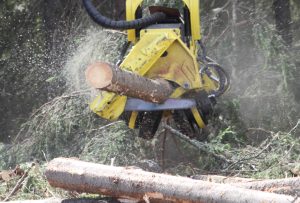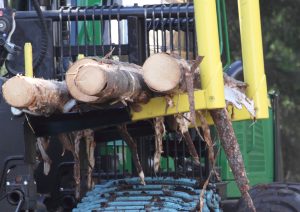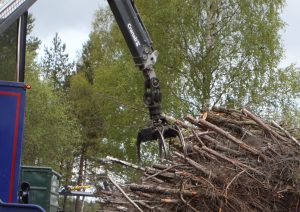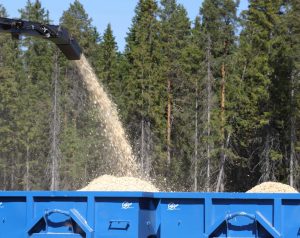Now we know who both the sellers and the buyers of Swedish wood are. Before we go into the cutting itself, in commercial thinning and clear-cutting, let´s have a look at what it actually is that´s being bought and sold, and who decides about qualities and volumes?
Assortments
There are three main assortments in the Swedish forestry; saw logs, pulp wood and energy wood from Norwegian Spruce (Picea Abies) and Scots Pine (Pinus Silvestris). The saw logs are the most valuable ones, and to get them in highest possible value is normally the goal for every forest owner.
There are, however, a number of special assortments, especially in hardwoods, for example for furniture, flooring and furnishing. The volumes of those special assortments are small but can be very profitable to check up if you are a forest owner. Especially as the normal use of hardwoods in Sweden is for pulpwood which is not so valuable.
Pulpwood
Pulpwood is for manufacturing of all kinds of paper products. It´s divided in three types: spruce pulpwood, softwood pulpwood and hardwood pulpwood. There are two different qualities: Firsts and seconds/2nds.
Spruce pulpwood has to be a clean assortment of Norwegian Spruce with as good as no root rot (max 2 % of a total pile in both qualities).
Softwood pulpwood is a mix of softwoods; Scots Pine, Norwegian Spruce, Lodgepole Pine and Larch. Here the root rot could be 5 % in firsts and 25 % in 2nds.
Hardwood pulpwood is a mix of hardwoods except Oak (Quercus Robur) and Ulm (Ulmus Glabra). The rules for root rot are the same as for softwood pulpwood.
Pulpwood lengths and diameters
Either fixed lengths or falling lengths are used for pulpwood. The fixed lengths are normally 3 meters with an allowed variation of +/- 30 centimeters. The falling lengths are 3 – 5,5 meters with the same variation as for the fixed lengths.
The minimum diameter is normally 5 centimeters, and the maximum is 70 centimeters.
Saw logs
The demands for saw logs in Sweden varies a lot. The industry has, however, agreed on a basic system for quality classification. The system can be modified by single buyers to suit their particular sawmill and demands.
Softwood saw logs are normally cut in suitable lengths between 3,1 and 5,5 meters, in 0,3-meter steps (3,1 – 3,4 – 3,7 – 4,0 – 4,3 meters and so on). The cut should be placed 1 – 3 centimeters above the actual length to be approved. It´s very important that the log is not shorter than the chosen length.
The diameter of the saw logs is measured at the top end of the log and for “normal” saw logs the minimum diameter is 16 centimeters under bark. There is a special assortment called “small saw logs” that could be cut between 12 – 16 centimeters under bark in the top end of the log. The lengths for these thin logs are the same as for the normal ones.
Qualities for saw logs
As always in Sweden, we only speak about the softwood species Scots Pine and Norwegian Spruce. For Scots Pine there are four quality levels and for Norwegian Spruce, there are two. They are simply numbered 1 – 4 and 1 – 2. The best quality logs have to be straight, free from rot and damages, have small fresh branches and not too wide annual rings.
Hardwood saw logs
There are a handful of hardwood sawmills in Sweden. They pay quite good for high quality logs but as they are spread out geographically, not every forest owner can sell to them. The difference in price compared to pulpwood is so big that it certainly is worth checking where the closest hardwood sawmill is located.
Energy wood
When a clear cut is made there will be lots of brush and tops left on the site. As most forest owners wants to replant the sites as soon as possible the normal procedure is that brush and tops are removed from the site, stacked for drying and then chipped on site. The chips are transported to a combustion plant for district heating, power production or both.
Another type of material that is being used for bioenergy production is what grows on roadsides, field sides and power lines. This material has become a valuable assortment instead of just cutting it down and leave it on site.
Measuring the wood
As good as all wood that is cut in Sweden is measured by Biometria which is an organization where all major forest industries are members. They support timber trading, logistics and production on the Swedish wood market. Biometria offer digitalization and automatization of the timber flow, but also have a close cooperation with universities and research institutes.
Their task is to be an independent part for measuring all the wood that flows between the forest and the forest industry, and to make sure that both sellers and buyers feel secure in their trading.
Sources: skogskunskap.se, biometria.se
Photos: Per Jonsson















